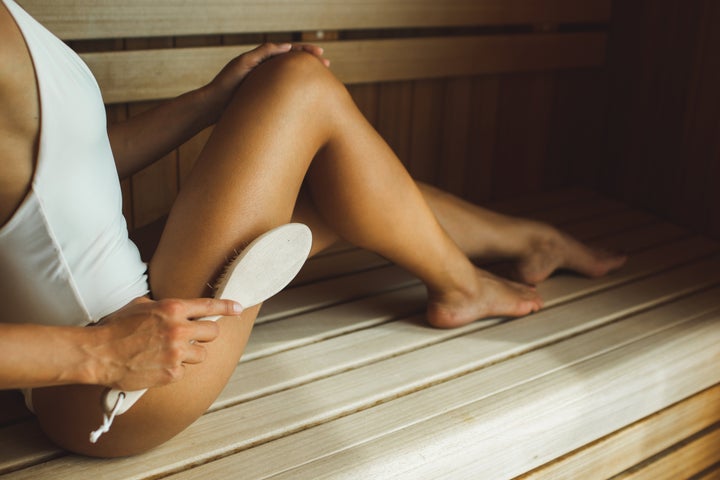
With our skin care routines becoming more high tech every day, there’s something refreshing about the old-fashioned simplicity of dry brushing, the practice of running a bristled brush across dry skin. It’s a beauty technique that’s been around for centuries — many ancient cultures had some version of the treatment, including the Indian practice of ayurveda, in which the dry-brush technique of garshana massage is used to stimulate circulation and blood flow.
Thousands of years after the development of the technique, people are still extolling the virtues of the practice, including a T-shirt-clad Gwyneth Paltrow, who kicked off 2022 by giving a dry brushing demonstration on her Instagram feed.
Proponents of a pre-shower dry brush say that, at a minimum, the practice can slough away dead skin cells and improve circulation. Others tout heightened benefits that include the ability for regular dry brushing to help lymphatic drainage, aid in digestion and kidney function, and even reduce the appearance of cellulite.
But what’s the real story?
Here’s what science says
“True data on the actual effects of dry brushing on the skin are lacking,” dermatologist Sumayah Taliaferro told HuffPost. “A search of the medical literature reveals very little concrete information.” Still, she said, “practitioners of traditional medicine are learning more and more from Eastern medicine, and dry brushing, despite a lack of scientific evidence, has mild therapeutic benefits, which include exfoliation of the skin and improved circulation.”
“By stimulating microcirculation, the skin can look more vibrant and radiant after dry brushing,” Taliaferro added.
With all that dry, old gunk whisked away, your pores will be wide open for any potions and lotions you’d like to apply. “Once the dead skin cells, which may have been blocking skin care products’ ability to penetrate the skin, are removed, you may see more hydrated, silky and glowing skin if you follow up with your favorite body moisturizer,” dermatologist Hope Mitchell told HuffPost.
Stop it with the D word already
We know it’s one of Paltrow’s favorite terms, but “detox” doesn’t really have a place in the dry brush conversation, experts said. “It doesn’t ‘detox’ your body,” said dermatologist Jeannette Graf, assistant clinical professor of dermatology at Mount Sinai School of Medicine. “Excess sebum and dead skin can be removed, but dry brushing cannot remove ‘toxins’ from the body. The brushing does stimulate skin microcirculation, but our kidneys and liver are functioning daily to do all the detoxing that we need.”
If you’re equating “detox” with “pore opening,” the derms have bad news for you. “The claim I have heard is that dry brushing opens up the pores, increasing the ability to sweat and therefore increasing lymphatic flow, but I disagree with this claim,” dermatologist Rebecca Marcus told HuffPost. “Sweat is extruded through skin in a normal process that’s not dependent on pores being ‘open.’ The ‘detox’ function of the lymphatic system refers to the transportation and removal of waste products and abnormal cells, and the best way to support it is by making sure to consume plenty of fluids and by exercising. Muscle movements and contractions are essential to the lymphatic drainage process. Dry brushing, on the other hand, will not produce the same result.”
How to start dry brushing the right way
It’s done on dry skin, not wet, for a simple reason: Your skin is stronger that way. “By performing the process on dry skin instead of in the shower, the skin is in a sturdier state than it would be in a wet or humid environment, and therefore less prone to damage,” Marcus said.
Graf offered this quick-start guide: “Always do your dry brush before showering, and always move in an upward motion, starting from the bottom and moving upward. Don’t use a body brush on your facial skin, since that’s more sensitive. As soon as you’re done brushing, step into a tub or shower, and make sure to put on moisturiser afterward.”
And be cautious about what you’re applying at that final step. “Remember that the skin will be more sensitive to irritants after exfoliation, so it would be wise to avoid fragrance or other common irritants,” Marcus said.
“I recommend people dry brush once or twice weekly, as long as they don’t have sensitive skin or conditions such as eczema or psoriasis,” Mitchell said. “If done too frequently or too aggressively, dry brushing can cause small cuts in the skin and irritation. Also, don’t brush over open wounds, acne, moles, reddish or irritated skin, skin bumps, sunburns or skin cancer, and avoid any area with an active skin infection like warts.”
Which dry brush is best for you?
“I would look for a brush that is not too rough or abrasive, so it doesn’t damage the skin,” Marcus advised.
“Flat ones that wrap around the hand are great for the arms and legs, and brushes with long handles are ideal for treating the back and hard-to-reach areas on the body,” Taliaferro said. “When purchasing a long brush, look for one with two sides, with a choice of firmer and softer bristles.”